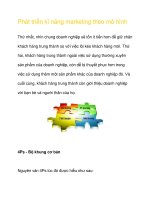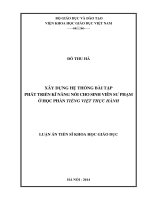Phát triển kĩ năngPresentation skills
Bạn đang xem bản rút gọn của tài liệu. Xem và tải ngay bản đầy đủ của tài liệu tại đây (193.4 KB, 42 trang )
Presentation Skills
Contents
1.Developing Great CONTENT
2.Preparing Great DESIGN
3.Conducting Great DELIVERY
Three Elements of Great
Presentation
Content
Design
Delivery
Great Presentation!
Developing Great CONTENT
Steps in Preparing Content
Analyzing
Your Audience
Gathering
Relevant Data
& Information
Converting
Your Data into
an Outline
Analyzing Your Audience
Needs
Knowledge level
Attitude – how do they feel about the topic?
Demographic Information – this may include the
age, gender, culture, and language of the
audience members
Gathering Relevant Data &
Information
Before you start your research to gather relevant
information, there are three questions should be
considered :
What do I want my audience to gain?
What might they already know about my topic?
What is the objective of the presentation?
Converting Your Information
into an Outline
There are three steps to creating an outline :
Determine the outline style
Group your raw data
Arrange into outline format
Outline Style
Chronological
Narrative
Problem/ Solution
Cause/ Effect
Shows events in order as they occurred
Takes the audience on a journey through
a flowing presentation
States the problem, the why’s, your solution,
and a summary
States the cause and explains the effects
Outline Style
Topical
Divides the general topic into
several subtopics
Journalistic
Uses some or all of the what,
who, where, when, why, and
how questions
Questions
Outline Format
Introduction
Outline Format
Body
Conclusion
Outline Format
Introductions
Should include an agenda and clarify the goals
and objectives of your presentation.
Can include an overview of a situation, a
statement of the current situation of the
organization, or a recap of history.
Can use the strategies that help an
introduction get attention: a quote, a question,
humor, a creative image, an anecdote, or a
sharing of emotions .
Outline Format
Body
Chronological
Narrative
Problem/Solution
Cause/Effect
Topical
Journalistic Question
Outline Format
Conclusion
Summarize the main points of your
presentation
Provide closure, and leave an impression
Can consist of recommendations, future
directions, next steps to take, and so forth
Building Great DESIGN
Presentation Design
Key Rules when Creating Bulleted Text:
Use one concept per slide
Use key words and phrases
Make your bullet points consistent in structure
Capitalize properly – capitalize the first letter of
the first word only
Three Keys of Great Design
Layout
Consistency
Color
Great Slide
Presentation
Design
Layout
Layout
Consider your layout to be like the skeleton of
your presentation….Just as our skeleton
support our bodies, your layout should support
your message and provide structure.
Consistency
Consistency
You must be consistent in the following design
elements:
Your placement of text and images
Your fonts style and sizes
Your background
The style and treatment of your imagery
Your charts
Color
Color
Use high contrast to increase legibility (e.g.,
black text on clear and yellow on dark blue)
Colors should not clash – they should have a
high degree of harmony
Avoid clutter by using no more than four colors
Consistent Fonts
The two main classifications of fonts are serif and
sans serif fonts
Serif fonts have small flourishes extending from
the main strokes of each letter (examples : Times
New Roman , Book Antiqua , Bookman Olds
Style , Garamond ). Sans serif don’t; they are
straight and clean (examples : Arial, Verdana ,
Helvetica )
Sans serif fonts are best suited for electronic
presentations
Tips for Planning Great
Slides
Use slides sparingly. Avoid the overuse of slides
or unnecessary slides.
Make slide pictorial. Graphs, flowcharts, etc., all
give the viewer an insight that would otherwise
require many words.
Make text and numbers legible. Minimum font
size for most room set-ups is 20 pt.
Make pictures and diagrams easy to see.
Design Guidelines
Avoid this
This is better
Effective Charts and Graphs
Avoid slide like this one...









